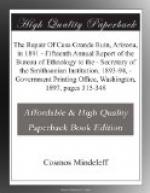When the work is completed it must pass the final inspection of the supervisor, or such person as the Secretary of the Interior may designate for the purpose.
1. CLEARING OUT THE DEBRIS
The debris now filling up the interior is to be removed down to the floor level, or the original ground level. The debris covering an area measuring 10 feet from the exterior walls of the building in every direction is also to be removed. This work is to be carried on in conjunction with the underpinning of the walls, and is to be dependent upon the progress of the latter, the work being done as required by the person holding the contract for the underpinning. All proper precautions must be observed during the progress of the work to prevent any injury to the building, the walls being properly braced and supported before excavation is commenced. The contractor will be held responsible for any injury to the building. Any objects found of archeologic or other value properly belong to the United States and must be deposited in the National Museum. The material removed from the building and from the area about it is to be removed to a proper distance, not less than 100 yards from the building. Proper drainage channels must be provided to keep the excavated area permanently clear of water.
2. UNDERPINNING WALLS
The walls where eroded at the ground level are to be underpinned with hard-burned brick, laid in good cement mortar and extending to a depth of at least 12 inches below the original ground level. This work must be carried on gradually and very carefully in conjunction with the clearing out of the debris. The under surfaces of the overhanging walls must be carefully trimmed to afford solid horizontal bearings against the brickwork. The face of the brickwork is to be set back at least 1 inch and not more than 2 inches from the face of the wall, and the brickwork is to be plastered with a coating of cement mortar, 1 to 2 inches thick, bringing it out flush with the outer wall.
3. FILLING IN OPENINGS
The broken-out lintels of openings are to be replaced by wooden lintels composed of squared lumber, 2 by 4 inches in size, laid side by side across nearly the whole thickness of the walls, with not more than 1 inch space between the boards, and of the same length as the original lintels. The broken-out walls are to be trimmed to afford solid resting places for the new lintels, which are to occupy the same horizontal planes that the old ones did. The openings above the lintels are to be filled in in the same manner as the underpinning previously described, the tinder wall surfaces being carefully dressed to afford solid horizontal bearings, the brick work being set back 1 inch from the wall surfaces and plastered with a coating of cement mortar to bring it out flush with the wall.
4. BRACING




